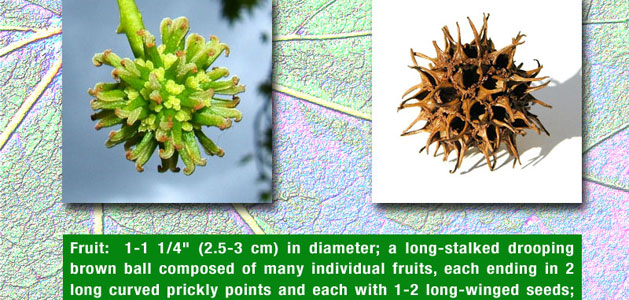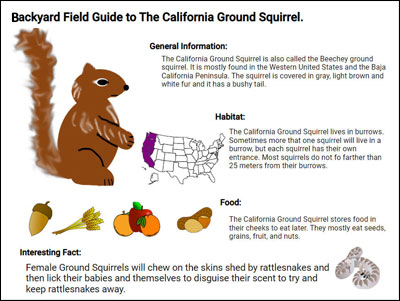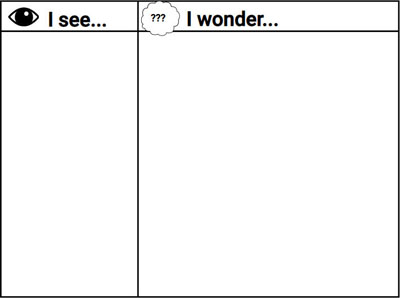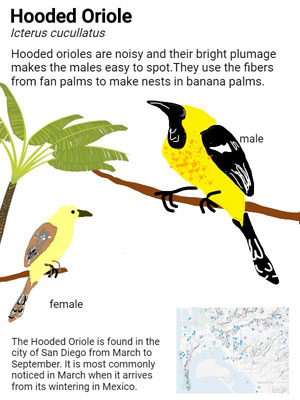Fantastic Field Guides
Students explore the plant and animal species where they live and design their own field guide to teach others about the species in this habitat.

Task
A field guide catalogues the diversity of plants and animals found in a geographic region. But even within a small geographic area there can be a wide range of habitats, as well as plant and animal species.
In this lesson, students work as biologists to identify and catalog the species found in their local area and create a field guide specific to the species in their own backyard.
Engage
Kick off this project by introducing your students to some of the unique species local to your area. You may have already engaged your learners by studying and releasing butterflies or commenting on beautiful birds outside of your classroom window.
Many students hike with families or go fishing and have a strong knowledge base in a particular area. If you have such a student, encourage them to share their expertise through a show-and-tell presentation or even a passion project.

You might also connect with a local nature center or animal rehabilitation center and coordinate a field trip. It may be easier to arrange for a ranger, or parent expert, to visit your classroom. A site visit that involves plants, animals, and/or insects is a sure-fire way to get students excited about the animals that live around them.
Take your students on a walk around your school property, neighborhood, or local park. Use devices to capture photos of the plants and animals you find.
Give students time to sketch and take notes about a particular species they find. If you are working with younger learners, you may want to guide their observations with an I See, I Wonder approach.

When you return to the classroom, have students work in small teams to identify some of the species you have observed. Provide printed field guides or brochures, as well as links to online field guides. For example, the Go Botany site helps you narrow down your search using a series of questions about the characteristics plants.
Depending on the detail of their photo, sketch, or notes, students may have trouble identifying a specific species when they return to the classroom. The goal of the nature walk and observation was not to get the answer correct but to help students understand the importance of noting important information such as:
- Color — were the bird’s legs black or yellow?
- Shape — was a tree tent-shaped or round?
- Texture — was the bark smooth or deeply grooved?
- Location — was a bird high in the tree or on the ground?
While it may be easy to identify some species, like a Robin or Zebra Swallowtail butterfly, many different species look alike! Discuss some of these species such as Monarch and Viceroy butterflies. These discussions often help deepen student’s understanding about mimicry and other adaptations.
Create
Assign or ask students to choose a specific species in your local habitat they are interested in learning about.
Provide students with online and print resources for their species. Depending on the age of your learners, you may want to provide structure as they complete their research. For example, you could ask them to be sure their notes answer:
- What does this animal look like? (physical characteristics)
- What does this animal eat? (diet)
- Within a habitat, where can this animal be found? (habitat)
- When is this animal active? (behavior)
If your students are ready, work as a class to develop the list of key information and details their research should include.
Most field guides are designed to provide general information about a species and places where it lives. Make sure that students include specific information in their field guide entries about finding and identifying their species where you live.

Work as a class to determine what topics and information will be covered for each species, such as physical traits and habitat.
You may want to revisit nonfictional text features such as photographs, captions, labels, headings, maps, and charts.
Once you have developed necessary criteria for your field guide, have students use a tool like Wixie to design their field guide entry. You can assign individual paragraphs as homework to help save classroom time.
While students can find photographs of many species in the Pics4Learning library embedded in Wixie, take a hint from John James Audubon and have students create their own images of the species. Students can use the paint tools in Wixie, or use colored pencils and capture the image with a device's camera.
Share
If you worked on the field guide as a class, print out each student’s page and bind them together to create a printed version you can keep in your classroom or school library. If you use Wixie, make this process easier, by combining their individual work together using Wixie’s Project Wizard feature.
If you would like a more professional looking product, download the Wixie pages as JPG files and upload them to a photo-sharing site. If you can’t get funding to create a book for each student, link to the online version so everyone can view the project. You may also want to share a link to the “photo” book so that families can purchase individually.
Share a printed version with a local nature center or the rangers at a park in your local community. You could also have your students act as the rangers for a younger class observing the species around your school.
Share the URL to the final Wixie guide on your classroom website, so other students and community members can learn about the species they will find in your area. You can also export the class book as an eBook, so students can read and enjoy on their iPads at home.
Assessment
Create a rubric or checklist to help guide student work during research, writing and final submissions.
Review initial student sketches to evaluate their observation skills and attention to details through their sketching and note taking. How well did they take note of specific features, such as size, shape, and texture, so they could later identify?
Check in with each student as they begin to explore and research their chosen species, so that you can clarify misconceptions before they begin to design their field guide entry. Depending on the age of your learners, you can use a worksheet to provide support and structure as they complete their research.
The final field guides, or field guide entries, serve as a performance task you can use to evaluate student understanding of science learning goals, such as how organisms in a particular habitat survive or how variations can occur in characteristics among individuals of the same species. The field guide entries can also help evaluate student's informative writing skills.
Resources
Nicola Davies. Extreme Animals: The Toughest Creatures on Earth. ISBN: 0763641278
Pamela Hickman. Animals in Motion: How Animals Swim, Jump, Slither and Glide. ISBN: 1550745751
National Audubon Society - online bird guide
Cornell Lab of Ornithology - All About Birds
Native Plant Trust - Go Botany (great for identifying from features)
Pl@ntNet - Identify
Standards
Next Generation Science Standards - Life Science Grades 3-5
1-LS3-1 Heredity: Inheritance and Variation of Traits
Use observations to describe patterns of what plants and animals (including humans) need to survive.
1-LS3-1 Heredity: Inheritance and Variation of Traits
Make observations to construct an evidence-based account that young plants and animals are like, but not exactly like, their parents.
2-LS4-1 Biological Evolution: Unity and Diversity
Make observations of plants and animals to compare the diversity of life in different habitats.
3-LS2-1 Ecosystems: Interactions, Energy, and Dynamics
Construct an argument that some animals form groups that help members survive.
3-LS3-2 Heredity: Inheritance and Variation of Traits
Use evidence to support the explanation that traits can be influenced by the environment.
3-LS4-2 Biological Evolution: Unity and Diversity
Use evidence to construct an explanation for how the variations in characteristics among individuals of the same species may provide advantages in surviving, finding mates, and reproducing.
3-LS4-3 Biological Evolution: Unity and Diversity
Construct an argument with evidence that in a particular habitat some organisms can survive well, some survive less well, and some cannot survive at all.
4-LS1-1 From Molecules to Organisms: Structures and Processes
Construct an argument that plants and animals have internal and external structures that function to support survival, growth, behavior, and reproduction.
Common Core Anchor Standards for English Language Arts - Grade K-5
Writing Theme
Text Type and Purpose
2. Write informative/explanatory texts to examine and convey complex ideas and information clearly and accurately through the effective selection, organization, and analysis of content.
Production and Distribution of Writing
4. Produce clear and coherent writing in which the development, organization, and style are appropriate to task, purpose, and audience.
Research to Build Present Knowledge
7. Conduct short as well as more sustained research projects based on focused questions, demonstrating understanding of the subject under investigation.
ISTE Standards for Students
3. Knowledge Constructor
Students critically curate a variety of resources using digital tools to construct knowledge, produce creative artifacts and make meaningful learning experiences for themselves and others. Students:
a. plan and employ effective research strategies to locate information and other resources for their intellectual or creative pursuits.
b. evaluate the accuracy, perspective, credibility and relevance of information, media, data or other resources.
c. curate information from digital resources using a variety of tools and methods to create collections of artifacts that demonstrate meaningful connections or conclusions.
6. Creative Communicator
Students communicate clearly and express themselves creatively for a variety of purposes using the platforms, tools, styles, formats and digital media appropriate to their goals. Students:
a. choose the appropriate platforms and tools for meeting the desired objectives of their creation or communication.
b. create original works or responsibly repurpose or remix digital resources into new creations.
d. publish or present content that customizes the message and medium for their intended audiences.









